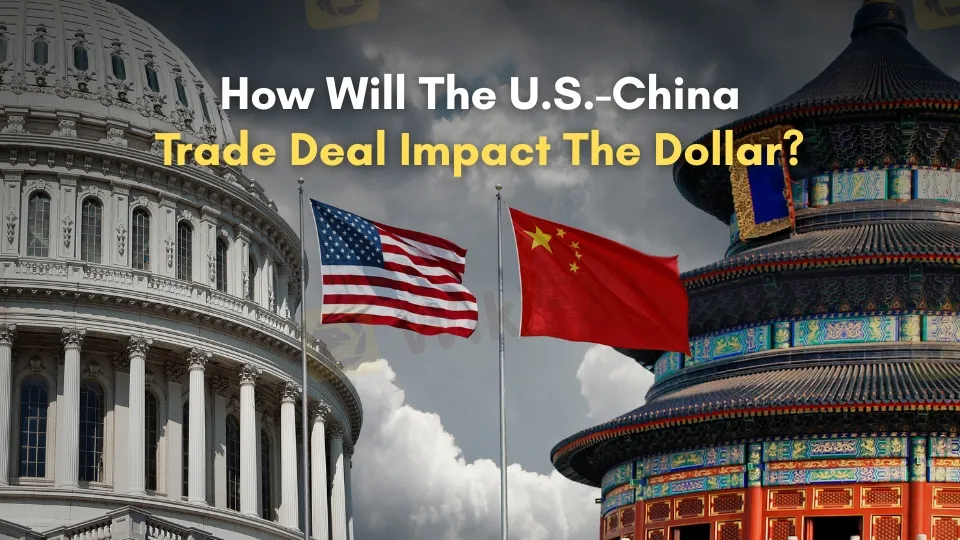How Will the U.S.-China Trade Deal Affect the Dollar and Global Markets?
Abstract:The U.S. dollar surged after the U.S. and China agreed to temporarily cut tariffs, easing concerns over a global recession and boosting market sentiment.

On Monday, a breakthrough in U.S.-China trade talks sent the U.S. dollar climbing and ignited a surge in global stock markets. The two economic powerhouses struck a temporary deal to scale back tariffs, calming fears that their ongoing trade spat could drag the world into a recession. This unexpected agreement has injected a dose of optimism into financial markets, with investors eagerly watching what comes next.
Under the deal, the U.S. will slash extra tariffs on Chinese goods from 145% to 30%, while China will lower its duties on U.S. imports from 125% to 10%. The truce, set to last 90 days, gives both nations a chance to work toward a longer-term resolution. “This pause is a relief, but it‘s just a breather,” said Sarah Mitchell, a trade analyst at Horizon Economic Group in Boston. “We’re still far from solving the deeper issues driving this conflict.”
The agreement caught many by surprise, as earlier talks had hinted at little progress. Yet, the news was a boon for markets. The U.S. Dollar Index, which measures the dollar against major currencies like the euro and yen, jumped 1.5% to 101.91. The euro took a hit, dropping 1.54% to $1.1074—its biggest single-day slide since early November. The dollar also gained 2.19% against the Japanese yen, reaching 148.50, its highest since April, and rose 1.86% against the Swiss franc to 0.847. The British pound wasnt spared, falling 1.07% to $1.3162, marking its steepest daily drop since April.

U.S. stocks rode the wave of optimism, with the S&P 500 soaring over 3%. Safe-haven currencies, typically favored during uncertain times, lost ground as investors embraced riskier assets. “The market‘s cheering this deal, but it’s a short-term fix,” Mitchell noted. “The next 90 days will be crucial to see if both sides can build on this momentum.”
Despite the dollar‘s recent gains, it’s still down 2.2% since April, when President Trump‘s sweeping tariff announcements rattled markets. The uneven rollout of those policies sparked volatility, shaking confidence in U.S. assets. Now, attention is turning to key economic data: Tuesday’s Consumer Price Index (CPI) and Thursdays retail sales figures. These reports will shed light on how the trade dispute has affected the economy and shape expectations for Federal Reserve interest rate moves.
Investors are rethinking their bets on rate cuts, with the trade deal easing economic concerns. Many now expect the Feds first 25-basis-point cut in September, a shift from earlier predictions of a July move. “This deal gives the Fed room to hold steady on rates, which supports the dollar for now,” said analysts at Cornerstone Wealth Advisors. The Chinese yuan also saw a modest gain, rising 0.52% to 7.201 against the dollar, signaling cautious optimism in China.
Beyond trade, the weekend brought relief on the geopolitical front. India and Pakistan agreed to a ceasefire after days of border clashes, soothing jittery markets. Meanwhile, Ukrainian President Volodymyr Zelenskyy signaled openness to meeting Russian President Vladimir Putin in Turkey for talks—the first potential dialogue since Russias 2022 invasion of Ukraine. These developments have bolstered global risk sentiment, adding to the positive market mood.
As the dust settles, investors are hopeful but cautious. The U.S.-China trade truce is a step forward, but whether it leads to lasting progress or just delays tougher challenges remains to be seen.

Read more

What Makes AvaTrade a Force to Reckon with?
AvaTrade. The name that transpires hope. The name that transpires transparency. The name that transpires gains for traders like you. Read it to know how it helps traders make gains from the forex market.

Top Tips to Choose the Best Forex Broker in 2025
You need a solid forex broker to make the most of the currency fluctuation. The strategies they use to take you through the ups and downs of forex trading are beyond words. While the strategies may seem solid, the eventual gains matter more. That’s where you need to take notice of the forex brokers, how they approach, their fee structure, rating, etc. To help you evaluate forex brokers better, we have this guide for you. Read it to choose the right forex broker in 2025.

Rupee Continues to Fall Under Robust Demand for US Dollar
Rupee continued to fall for the sixth time in seven trading sessions on Wednesday (June 4, 2025) under robust demand for the US dollar. The Indian National Rupee slipped past 86 to the US dollar. The fall is attributable to the bullish bets made by traders for the USD. The day saw the rupee falling to 86.025 before recovering to end the day at 85.90. It was 0.4% lower than the previous day's close.

Fraudsters Are Targeting Interactive Brokers' Users with Lookalike Emails
Interactive Brokers (IBKR) has warned its clients about a growing number of scams where criminals pretend to be from the company.
WikiFX Broker
Latest News
ASIC Urges Financial Licensees to Fix Register Errors Before 2026 Deadline
eToro Review 2025: Top Trading Opportunities or Hidden Risks?
How much money will you earn by investing in Vantage Broker?
IronFX vs Exness Review 2025: Comprehensive Broker Comparison
Fraudsters Are Targeting Interactive Brokers' Users with Lookalike Emails
Top Tips to Choose the Best Forex Broker in 2025
Everything you need to know about ADSS
SEBI Notifies New F&O Rules for Investors - New Derivative Trading Limits & More Amendments
Interactive Brokers: Global Office Visits and Licensing Details
U.S. Jobs Data Released: A Potential Boost for Gold Prices
Rate Calc
